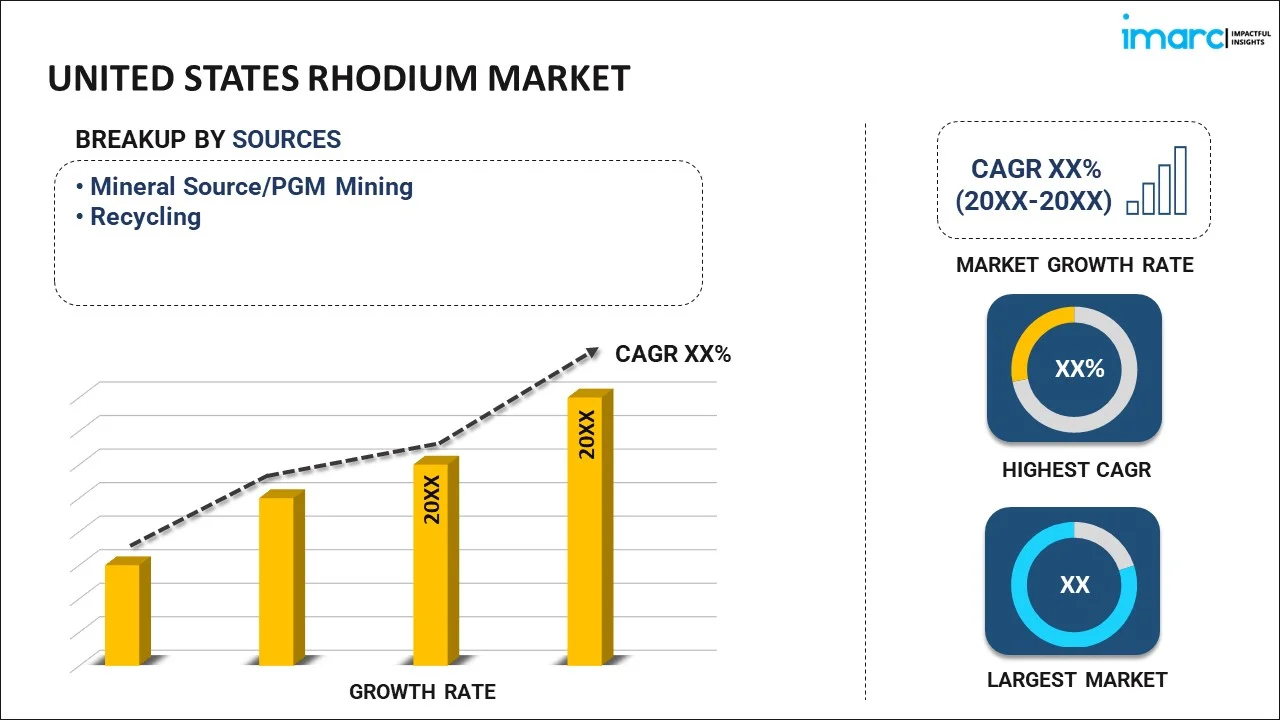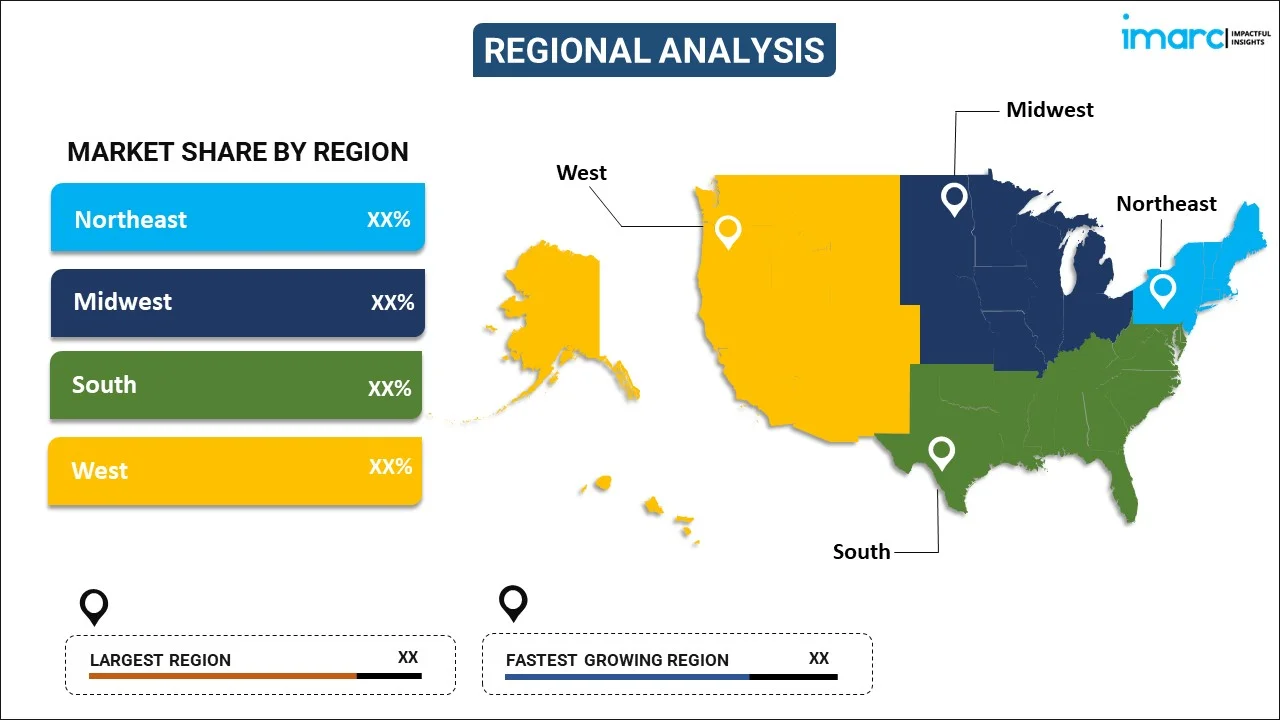
United States Rhodium Market Report by Source (Mineral Source/PGM Mining, Recycling), Product Type (Alloys, Metals and Compounds), Application (Catalysis, Jewelry Making, Platinum and Palladium Alloying, and Others), End Use Industry (Automotive, Chemical, Glass, Electricals and Electronics, and Others), and Region 2024-2032
Market Overview:
The United States rhodium market size is projected to exhibit a growth rate (CAGR) of 4.4% during 2024-2032. The increasing demand for rhodium in automotive catalysts for emission control, growing adoption of fuel cell technology, and shifting preferences toward renewable energy sources represent some of the key factors driving the market.
|
Report Attribute
|
Key Statistics
|
|---|---|
|
Base Year
|
2023
|
|
Forecast Years
|
2024-2032
|
|
Historical Years
|
2018-2023
|
| Market Growth Rate 2024-2032 | 4.4% |
Rhodium is a rare and valuable transition metal belonging to the platinum group of elements. It is a silver-white metal with a high melting point and excellent resistance to corrosion and tarnish. It is known for its remarkable properties, making it highly sought after and widely used in various applications. One of the primary uses of rhodium is in catalytic converters, which are essential components in automotive exhaust systems. Rhodium acts as a catalyst, facilitating the conversion of harmful gases, such as nitrogen oxides (NOx), carbon monoxide (CO), and hydrocarbons, into less harmful substances. Its exceptional catalytic properties help to reduce emissions and meet stringent environmental regulations for air pollution control. It also plays a crucial role in the electronics industry and is utilized as a coating material for electrical connectors, providing enhanced durability, superior corrosion resistance, and improved electrical conductivity. It is also employed in the production of jewelry. Its lustrous appearance and resistance to tarnish make it a popular choice for plating white gold and silver jewelry, giving them a brilliant and long-lasting shine. In addition to this, rhodium is widely used in chemical synthesis as a catalyst in various reactions, including hydrogenation, hydroformylation, and carbonylation, enabling more efficient and selective chemical transformations.
United States Rhodium Market Trends:
In the United States, the rising demand for rhodium in automotive catalysts, increasing environmental regulations, and the elevating need for stringent emission control represents the primary factor driving the market growth. Rhodium is a vital component in catalytic converters, which help reduce harmful emissions from vehicles. Moreover, fuel cells utilize rhodium as a catalyst for electrochemical reactions, providing clean and efficient energy. Along with this, the growing interest in fuel cell technology has augmented the demand for rhodium. Apart from this, rising investment and research in fuel cell development by the government of United States is another major growth-inducing factor. Additionally, electrolyzers produce hydrogen by splitting water molecules, and rhodium catalysts play a significant role in improving the efficiency of this process. In line with this, the rising utilization of rhodium in electrolyzers owing to the escalating demand for renewable energy sources, such as hydrogen fuel cells, is propelling the market growth. Besides this, the increasing demand for rhodium in the automotive industry and emerging technologies like fuel cells and electrolyzers due to increasing environmental regulations and the augmenting demand for sustainable technologies are contributing to the market growth. Other factors, including the rapid expansion in the automotive industry, increasing consumer expenditure on jewelry, and the heightening focus on enhancing the luster and durability of metals, are also anticipated to drive the market further.
United States Rhodium Market Segmentation:
IMARC Group provides an analysis of the key trends in each segment of the United States rhodium market report, along with forecasts at the country level for 2024-2032. Our report has categorized the market based on source, product type, application, and end-use industry.
Source Insights:

- Mineral Source/PGM Mining
- Recycling
The report has provided a detailed breakup and analysis of the market based on the source. This includes mineral source/PGM mining and recycling.
Product Type Insights:
- Alloys
- Metals and Compounds
A detailed breakup and analysis of the market based on the product type has also been provided in the report. This includes alloys and metals and compounds.
Application Insights:
- Catalysis
- Jewelry Making
- Platinum and Palladium Alloying
- Others
A detailed breakup and analysis of the market based on the application has also been provided in the report. This includes catalysis, jewelry making, platinum and palladium alloying, and others.
End Use Industry Insights:
- Automotive
- Chemical
- Glass
- Electricals and Electronics
- Others
A detailed breakup and analysis of the market based on the end use industry has also been provided in the report. This includes automotive, chemical, glass, electricals and electronics, and others.
Regional Insights:

- Northeast
- Midwest
- South
- West
The report has also provided a comprehensive analysis of all the major regional markets, which include Northeast, Midwest, South, and West.
Competitive Landscape:
The report has also provided a comprehensive analysis of the competitive landscape in the United States rhodium market. Competitive analysis such as market structure, key player positioning, top winning strategies, competitive dashboard, and company evaluation quadrant has been covered in the report. Also, detailed profiles of all major companies have been provided.
United States Rhodium Market Report Coverage:
| Report Features | Details |
|---|---|
| Base Year of the Analysis | 2023 |
| Historical Period | 2018-2023 |
| Forecast Period | 2024-2032 |
| Units | US$ Million |
| Scope of the Report | Exploration of Historical and Forecast Trends, Industry Catalysts and Challenges, Segment-Wise Historical and Predictive Market Assessment:
|
| Sources Covered | Mineral Source/PGM Mining, Recycling |
| Product Types Covered | Alloys, Metals and Compounds |
| Applications Covered | Catalysis, Jewelry Making, Platinum and Palladium Alloying, Others |
| End Use Industries Covered | Automotive, Chemical, Glass, Electricals and Electronics, Others |
| Regions Covered | Northeast, Midwest, South, West |
| Customization Scope | 10% Free Customization |
| Report Price and Purchase Option | Single User License: US$ 3699 Five User License: US$ 4699 Corporate License: US$ 5699 |
| Post-Sale Analyst Support | 10-12 Weeks |
| Delivery Format | PDF and Excel through Email (We can also provide the editable version of the report in PPT/Word format on special request) |
Key Questions Answered in This Report:
- How has the United States rhodium market performed so far and how will it perform in the coming years?
- What has been the impact of COVID-19 on the United States rhodium market?
- What is the breakup of the United States rhodium market on the basis of the source?
- What is the breakup of the United States rhodium market on the basis of the product type?
- What is the breakup of the United States rhodium market on the basis of the application?
- What is the breakup of the United States rhodium market on the basis of the end use industry?
- What are the various stages in the value chain of the United States rhodium market?
- What are the key driving factors and challenges in the United States rhodium market?
- What is the structure of the United States rhodium market and who are the key players?
- What is the degree of competition in the United States rhodium market?
Key Benefits for Stakeholders:
- IMARC’s report offers a comprehensive quantitative analysis of various market segments, historical and current market trends, market forecasts, and dynamics of the United States rhodium market from 2018-2032.
- The research study provides the latest information on the market drivers, challenges, and opportunities in the United States rhodium market.
- Porter's five forces analysis assist stakeholders in assessing the impact of new entrants, competitive rivalry, supplier power, buyer power, and the threat of substitution. It helps stakeholders to analyze the level of competition within the United States rhodium industry and its attractiveness.
- Competitive landscape allows stakeholders to understand their competitive environment and provides an insight into the current positions of key players in the market.
Need more help?
- Speak to our experienced analysts for insights on the current market scenarios.
- Include additional segments and countries to customize the report as per your requirement.
- Gain an unparalleled competitive advantage in your domain by understanding how to utilize the report and positively impacting your operations and revenue.
- For further assistance, please connect with our analysts.
 Inquire Before Buying
Inquire Before Buying
 Speak to an Analyst
Speak to an Analyst
 Request Brochure
Request Brochure
 Request Customization
Request Customization




.webp)




.webp)












